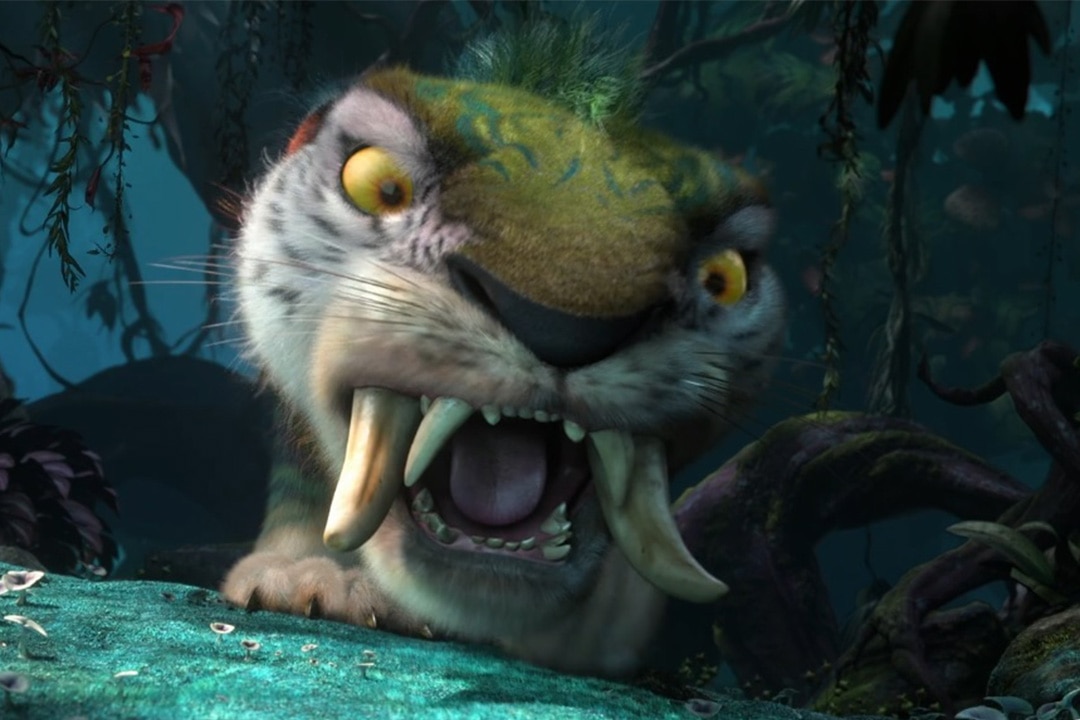Create a free profile to get unlimited access to exclusive videos, sweepstakes, and more!
Saber-tooth Cats Probably Couldn't Roar and May Have Purred Like House Cats
Analysis of saber-tooth cat throat bones reveals they may have purred like housecats.

The 2013 animated film The Croods (streaming now on Peacock) takes viewers back in time, to the birth of humanity. Our entry into this ancient world is facilitated by a family of primitive humans called the Croods. After a series of natural disasters pushes them out of their cave, they end up in the jungle and at the mercy of a massive, brightly colored, saber-tooth cat.
Finding a group of interlopers in its midst, the large cat does exactly what you expect it to do, planting its feet in the dirt and roaring to assert its dominance. Only later do the Croods and the cat (now named Chunky) put their differences aside and join forces. It’s hard to imagine that any cave people actually had a saber-toothed cat as a pet, but even if they did it almost certainly didn’t roar, according to a recent paper published in the Journal of Morphology.
The Roar (or Purr) of the Saber-tooth Cat
This wasn’t always a mystery. If you had the misfortune of being a human being more than 10,000 years ago, there’s a decent chance you were intimately aware of what a saber-tooth cat sounded like. That knowledge, however, has been lost to time, and scientists are trying to get it back.
RELATED: New Species of 600-Pound Saber-toothed Cat Once Prowled North America
It makes intuitive sense that saber-tooth cats would roar, given their size and ferocity. Today, real world cats fall mostly into one of two groups. You have the small cats like lynxes, ocelots, and housecats; and you have the big cats like lions, tigers, and leopards. They differ in size, but they also differ in skeletal anatomy. As a general rule, big cats roar and small cats purr, and it all comes down to differences in the physiology of their throats.
When chasing down vocalizations, scientists usually look to the hyoid bones in the throat. Humans have just one, perched beneath the jaw. It anchors soft tissues in the vocal tract and supports vocalizations. Those soft tissues don’t preserve when animals die, but paleontologists can infer the throat setup by looking at the bones. The hyoid serves the same purpose in cats, but they have a bunch more of them. Small purring cats have nine hyoid bones, while large roaring cats have seven.
Hyoid bones are rare in the fossil record, but we know that Smilodon fatalis (the saber-tooth tiger) had seven hyoid bones, the same as the modern roaring cats. But that isn’t the whole story.
It’s Not the Number of Hyoids, But How You Use Them
Saber-tooth cats branched off before either of the two modern groups of cats. That means that all modern cats are more closely related to one another than any of them are to Smilodon. It also means that recreating their anatomy is a challenge because there aren’t any direct living analogues.
Fortunately, Smilodon hyoids are more abundant than other animals, because of the La Brea tar pits in California. Researchers analyzed 105 Smilodon hyoid bones recovered from the site and compared them to four species of roaring cats and five species of purring ones. Their hypothesis was that the number of bones isn’t as important as their size, shape, and organization. In particular, they focused on the hyoid bones closest to the vocal apparatus, which are presumably more important for supporting the vocal structures.
RELATED: The Extinction of Saber-Toothed Cats and Dire Wolves May Have Been Written in Their Bones
While Smilodon’s only have seven hyoid bones, the size and shape of the bones closest to the voice box were more similar to modern purring cats, suggesting that they likely sounded more like a house cat than a lion. However, the bones were considerably larger and more robust, suggesting that saber-tooth cats purred in comparatively low frequencies. They probably couldn’t roar, but that doesn’t mean their vocalizations wouldn’t shake your bones.
Maybe it’s best that we’re not quite sure what they sound like, that means they’re not eating us anymore. Of course, it would help to explain how the Croods managed to turn a predator into a house cat.
Catch The Croods (and Chunky!) streaming now on Peacock.



























